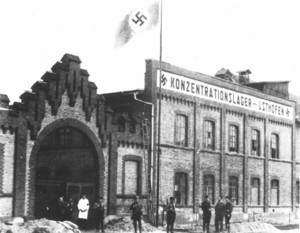
Osthofen Concentration Camp
Shortly after the Nazi government suspended most civil liberties in the "Reichstag Fire Decree" of February 28 1933, Dr Werner Best, State Commissioner for the police in Hesse since March 13 1933, ordered the creation of a concentration camp for the "People’s State of Hesse" in Osthofen. The Reichstag Fire Decree pretended to be directed at "Communist seditious acts of violence", but was used by the Nazi government to persecute all political opponents. Preceding this order, local Nazis had already seized an empty paper mill in early March 1933 and used it as a concentration camp for several hundred prisoners.
Dr Best’s actions sanctioned the existence of one of the first Nazi concentration camps in Germany. Officially the camp started operating on May 1st 1933. At the same time Dr Best used his newly created political state police to persecute political opponents. Nevertheless, the number of political prisoners in Hesse remained comparatively low. Unlike other concentration camps, no prisoner died in Osthofen during the camp’s 14 month existence. In the fall of 1933 Dr Best was dismissed as police commissioner and Hessian Prime Minister Philipp Wilhelm Jung was placed in charge of the concentration camp. In March 1934 Hermann Göring, formally in charge of the Hessian police, ordered Theodor Eicke, commander of the Dachau Concentration Camp, to restructure and standardize the existing Nazi concentration camps. In July 1934 the Osthofen Concentration Camp was finally disbanded.
Many former prisoners refrained from political activity after their release, hoping that the Nazi dictatorship would not last long. Others fled into exile or joined the fight against the fascist Franco regime in Spain. Yet for most, the terror was not over. They were under constant observation by the Gestapo, and many of them were repeatedly arrested and interrogated. Some detainees were deported to other camps like Dachau, Buchenwald and Mauthausen, the Emsland camps(Emslandlager) in Northwest Germany or were forced to join a special penal division, the Strafkompanie 999.
Origins of the prisoners
In the euphemistic language of the Nazis, political prisoners were placed in "protective custody" (Schutzhaft). Imprisonment in the Osthofen Concentration Camp was usually ordered by the county authorities of the People’s State of Hesse in its three provinces of Oberhessen, Starkenburg and Rheinhessen, where Osthofen is located. People from all over the state were imprisoned in Osthofen.




